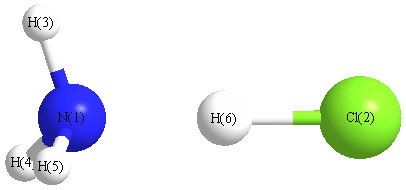All results from a given calculation for NH4Cl (Ammonium chloride)
using model chemistry: CCSD/daug-cc-pVTZ
19 10 17 12 22
States and conformations
| State |
Conformation |
minimum conformation |
conformer description |
state description |
| 1 |
1 |
yes |
C3V |
1A1 |
Energy calculated at CCSD/daug-cc-pVTZ
| | hartrees |
|---|
| Energy at 0K | -516.820334 |
| Energy at 298.15K | |
| HF Energy | -516.336053 |
| Nuclear repulsion energy | 48.739316 |
The energy at 298.15K was derived from the energy at 0K
and an integrated heat capacity that used the calculated vibrational frequencies.
Vibrational Frequencies calculated at CCSD/daug-cc-pVTZ
Geometric Data calculated at CCSD/daug-cc-pVTZ
Point Group is C3v
Cartesians (Å)
| Atom |
x (Å) |
y (Å) |
z (Å) |
|---|
| N1 |
0.000 |
0.000 |
-1.947 |
| Cl2 |
0.000 |
0.000 |
1.217 |
| H3 |
0.000 |
0.941 |
-2.322 |
| H4 |
0.815 |
-0.470 |
-2.322 |
| H5 |
-0.815 |
-0.470 |
-2.322 |
| H6 |
0.000 |
0.000 |
-0.094 |
Atom - Atom Distances (Å)
| |
N1 |
Cl2 |
H3 |
H4 |
H5 |
H6 |
| N1 | | 3.1638 | 1.0128 | 1.0128 | 1.0128 | 1.8531 |
Cl2 | 3.1638 | | 3.6622 | 3.6622 | 3.6622 | 1.3107 | H3 | 1.0128 | 3.6622 | | 1.6291 | 1.6291 | 2.4190 | H4 | 1.0128 | 3.6622 | 1.6291 | | 1.6291 | 2.4190 | H5 | 1.0128 | 3.6622 | 1.6291 | 1.6291 | | 2.4190 | H6 | 1.8531 | 1.3107 | 2.4190 | 2.4190 | 2.4190 | |
 More geometry information
More geometry information
Calculated Bond Angles
| atom1 |
atom2 |
atom3 |
angle |
|
atom1 |
atom2 |
atom3 |
angle |
| N1 |
H6 |
Cl2 |
180.000 |
|
H3 |
N1 |
H4 |
107.084 |
| H3 |
N1 |
H5 |
107.084 |
|
H3 |
N1 |
H6 |
111.764 |
| H4 |
N1 |
H5 |
107.084 |
|
H4 |
N1 |
H6 |
111.764 |
| H5 |
N1 |
H6 |
111.764 |
|
Electronic energy levels
Charges, Dipole, Quadrupole and Polarizability
